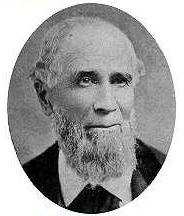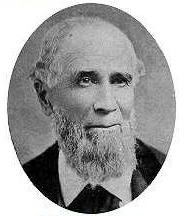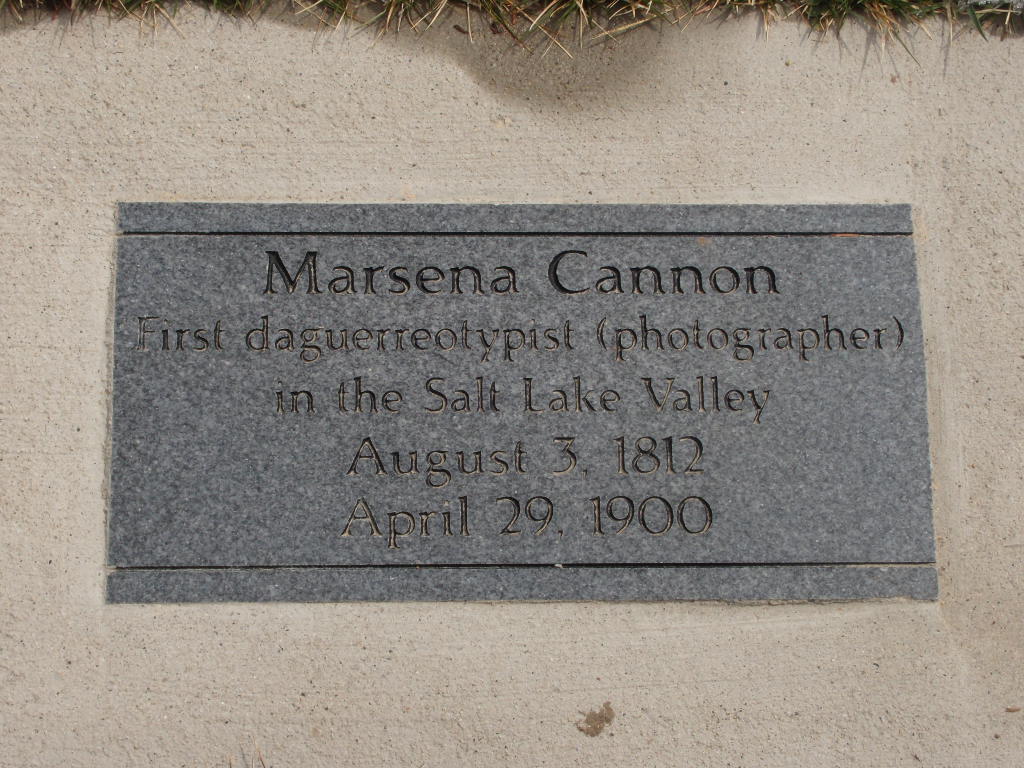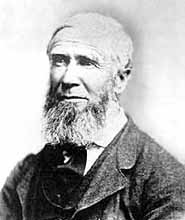Married Elizabeth Taylor Bowman, 29 September 1838, St. Albans, Somerset, Maine
Children - Children - Hiram Cannon, Mary Cannon, Bowman Cannon, Marsena Cannon, Sarah Cannon, Eron Cannon, Elizabeth Cannon
History - The first commercial photographer in Utah and the Intermountain West was in business, and the illustration in the advertisement was symbolic of his name: Marsena Cannon, age thirty-eight, recently of Boston, Massachusetts.
According to surviving records, and they are scanty, Marsena Cannon was born August 3, 1812, in Rochester. Stafford County, New Hampshire, not far from the border of Maine. His father, Hiram, was a prominent doctor in that region. Sometime around 1841 Marsena and his family moved to Boston where they met Mormon missionaries and were converted to the faith. They were listed as "members in good standing" of the Boston Branch in 1846, according to records filed at Cutler's Park, near Winter Quarters, Nebraska Territory, late in that year. Even though Cannon's membership records were filed in Nebraska Territory, the daguerreotypist and his family remained in Boston until 1850. His moves in that city, along with his professional connections, are detailed in Wilford Woodruff's journals between 1848 and 1850.
On March 7, 1848, while Woodruff was at Winter Quarters getting ready to depart for a mission to the East, he recorded in his journal: "I had a call from Dr. Cannon. He wished me to call and see his son Marsena Cannon, 75 Court Street, Plumbe's Dagaurious (sic) Gallery, Boston." Woodruff's entries for March 14 and May 16, 1849, and February 18, 1850, when he was in Boston, describe daguerreotypes taken by Cannon of his family. From Woodruff's entries also come concrete proof that Cannon learned the art of daguerreotypy from John Plumbe, Jr., one of the pioneers of American photography.
Plumbe opened a daguerreian gallery in Boston in 1840 and soon had a chain of galleries, operated by agents, in a number of eastern cities. He was the first to copy daguerreotypes on lithographic stone, which could explain Cannon's later interest in using his photographs to make engravings. But Plumbe and his agents met financial disaster in 1847, and the galleries were sold to meet the demands of creditors. Cannon and another agent, William Shew, kept Plumbe's Boston gallery in operation, however, first at 75 Court Street and later at 123 Washington Street. This can be proven from the entries in Woodruff's journals.
Cannon and his family departed for Utah in the spring of 1850. The photographer may have taken pictures of the wagon trip across the plains and of the Mormon settlements in the Nebraska Territory, but such a feat in those primitive surroundings was not likely, and Cannon later made no mention of this in his advertising.
Although he was not the first to make pictures on the western frontier, Marsena Cannon was the first to preserve them well enough to survive to our time. He was the first known resident photographer in Utah—the first to take daguerreotype portraits as well as pictures of buildings, landscapes, and news events. His are also the first street scenes of Salt Lake City.
The enterprising daguerreotypist dominated Utah photography for more than a decade, outlasting a handful of competitors who would set up shop and also advertise in the Deseret News. Occasionally he would take in a partner—sometimes the competitor who had advertised the week before in the News. Financially, such galleries could not have been very successful. In return for his services, Cannon advertised his willingness to accept cash or payment in kind. In 1857, for example, he ran this ad:
To All Saints:
Wanted: Hay, oats, peas, beans, butter, eggs, fox and wolf skins and cash for Likenesses . . . At the sign of the cannon. Open on Tuesdays, Thursdays, and Saturdays.
And in 1858:
Those persons who want likenesses, especially those to whom I am indebted will please call soon as I shall close business in a short time. M. Cannon.
During his heyday, Cannon photographed Brigham Young on a number of occasions, captured street scenes on both daguerreotype and ambrotype plates, covered the groundbreaking of the Salt Lake Temple in 1853, and photographed the old Salt Lake Tabernacle, the Beehive House, the Council House, and the General Storehouse and Tithing Office. He also made literally hundreds of portraits of early Salt Lakers. His portraits of Mormon authorities were engraved by Frederick Hawkins Piercy in Liverpool and printed in a beautiful sepia ink. Piercy also used several Cannon daguerreotypes in his Route from Liverpool to Great Salt Lake Valley, an immigrant guide to western America.
Several things happened between 1859 and 1861 to create a crisis in Cannon's career. New and perhaps better skilled photographers began arriving in the wagon trains from the East. Coincidentally, the art of daguerreotypy was being replaced by the new collodion, wet-plate process that allowed photographers to make enlarged prints in any quantity from a permanent glass negative. Although Cannon was Brigham Young's chief cameraman during the 1850s, the Mormon leader posed for another photographer—C. W. Carter—sometime near his sixtieth birthday in 1861.
One of the final dampers to Cannon's career came during the October conference of his church that same year. The names of the pioneer daguerreian and his one-time partner, L. W. Chaffin, were read from the pulpit to go to southern Utah to settle St. George and to grow cotton for the territory. James Bleak, historian for the St. George colonists, lists Cannon and Chaffin as the only two daguerreans out of the 309 names read at the conference. Bleak also lists them both in the census taken in St. George in 1862, indicating, at least, that the two photographers answered Brigham Young's call. Sometime before 1869, however, Cannon returned to Salt Lake City.
Cannon was a member of the Seventh Quorum of Seventy in Salt Lake City. His name can be found in the minute book of that organization—his participation was infrequent—together with a penciled notation obviously entered years later: "By his own request dropped from the Quorum."
Cannon's disaffection is explained, perhaps, by his alignment in 1869 with the so-called liberals in Utah, a group of Mormon businessmen and intellectuals who rebelled against the authoritarian policies of Brigham Young and formed the New Movement, later known as the Godbeites after one of its founders, druggist and general store proprietor William S. Godbe.
Just two days before the election of 1870, Godbe and his followers announced an Independent ticket, and among the nine candidates for city councilor was one Marsena Cannon, residing on First West Street, between North and South Temple.
The results of the election on Monday, February 14, 1870, proved to be a disaster for the liberal cause. Cannon, like the others on the Independent ticket, garnered less than three hundred votes.
The fate of the photographer from this point on is somewhat obscure. The last entry in the official records about the former daguerreian artist is made on a small white card filed in the "Old Church Record" in the LDS Church Historian's Office. Typewritten entries for Cannon, his wife, and children state simply: "Cut-off from the Church 1874."
According to Mrs. Olive Lulu Cannon Rasmussen of Ogden, a granddaughter, Cannon moved to California after his excommunication and lived for many years with his daughter Sarah in the San Francisco Bay Area. But when Sarah married, the photographer, then an old man, moved back to Utah to live with his son, Bouman, then manager of the Salt Lake County Infirmary and Poor Farm. Mrs. Rasmussen recalls visiting the old man at the infirmary sometime shortly before she married in 1899. Cannon would then have been eighty-seven. "He was sick and lying on a cot," Mrs. Rasmussen said. "I remember he cried because he didn't want to live away from his daughter Sarah." She did not remember her grandfather's dying, but his death must have occurred on the Poor Farm shortly after the visit. Nearly alone, most of his family scattered, severed from his church, and his life's work forgotten, the one-time daguerreian artist passed quietly from the scene, an unfitting end for the first resident photographer in Utah, the first to look through a camera lens upon the unspoiled beauty of the state, and the first to photo document the Mormons in their mountain refuge.
See: Our Pioneer Heritage, Carter, Kate B. Vol 18, pp 254-255," Early Pioneer Photographers."
Pioneers and Prominent Men of Utah, p. 246.
Mormon Pioneer Overland Travel, Wilford Woodruff Company (1850)
Married Elizabeth Taylor Bowman, 29 September 1838, St. Albans, Somerset, Maine
Children - Children - Hiram Cannon, Mary Cannon, Bowman Cannon, Marsena Cannon, Sarah Cannon, Eron Cannon, Elizabeth Cannon
History - The first commercial photographer in Utah and the Intermountain West was in business, and the illustration in the advertisement was symbolic of his name: Marsena Cannon, age thirty-eight, recently of Boston, Massachusetts.
According to surviving records, and they are scanty, Marsena Cannon was born August 3, 1812, in Rochester. Stafford County, New Hampshire, not far from the border of Maine. His father, Hiram, was a prominent doctor in that region. Sometime around 1841 Marsena and his family moved to Boston where they met Mormon missionaries and were converted to the faith. They were listed as "members in good standing" of the Boston Branch in 1846, according to records filed at Cutler's Park, near Winter Quarters, Nebraska Territory, late in that year. Even though Cannon's membership records were filed in Nebraska Territory, the daguerreotypist and his family remained in Boston until 1850. His moves in that city, along with his professional connections, are detailed in Wilford Woodruff's journals between 1848 and 1850.
On March 7, 1848, while Woodruff was at Winter Quarters getting ready to depart for a mission to the East, he recorded in his journal: "I had a call from Dr. Cannon. He wished me to call and see his son Marsena Cannon, 75 Court Street, Plumbe's Dagaurious (sic) Gallery, Boston." Woodruff's entries for March 14 and May 16, 1849, and February 18, 1850, when he was in Boston, describe daguerreotypes taken by Cannon of his family. From Woodruff's entries also come concrete proof that Cannon learned the art of daguerreotypy from John Plumbe, Jr., one of the pioneers of American photography.
Plumbe opened a daguerreian gallery in Boston in 1840 and soon had a chain of galleries, operated by agents, in a number of eastern cities. He was the first to copy daguerreotypes on lithographic stone, which could explain Cannon's later interest in using his photographs to make engravings. But Plumbe and his agents met financial disaster in 1847, and the galleries were sold to meet the demands of creditors. Cannon and another agent, William Shew, kept Plumbe's Boston gallery in operation, however, first at 75 Court Street and later at 123 Washington Street. This can be proven from the entries in Woodruff's journals.
Cannon and his family departed for Utah in the spring of 1850. The photographer may have taken pictures of the wagon trip across the plains and of the Mormon settlements in the Nebraska Territory, but such a feat in those primitive surroundings was not likely, and Cannon later made no mention of this in his advertising.
Although he was not the first to make pictures on the western frontier, Marsena Cannon was the first to preserve them well enough to survive to our time. He was the first known resident photographer in Utah—the first to take daguerreotype portraits as well as pictures of buildings, landscapes, and news events. His are also the first street scenes of Salt Lake City.
The enterprising daguerreotypist dominated Utah photography for more than a decade, outlasting a handful of competitors who would set up shop and also advertise in the Deseret News. Occasionally he would take in a partner—sometimes the competitor who had advertised the week before in the News. Financially, such galleries could not have been very successful. In return for his services, Cannon advertised his willingness to accept cash or payment in kind. In 1857, for example, he ran this ad:
To All Saints:
Wanted: Hay, oats, peas, beans, butter, eggs, fox and wolf skins and cash for Likenesses . . . At the sign of the cannon. Open on Tuesdays, Thursdays, and Saturdays.
And in 1858:
Those persons who want likenesses, especially those to whom I am indebted will please call soon as I shall close business in a short time. M. Cannon.
During his heyday, Cannon photographed Brigham Young on a number of occasions, captured street scenes on both daguerreotype and ambrotype plates, covered the groundbreaking of the Salt Lake Temple in 1853, and photographed the old Salt Lake Tabernacle, the Beehive House, the Council House, and the General Storehouse and Tithing Office. He also made literally hundreds of portraits of early Salt Lakers. His portraits of Mormon authorities were engraved by Frederick Hawkins Piercy in Liverpool and printed in a beautiful sepia ink. Piercy also used several Cannon daguerreotypes in his Route from Liverpool to Great Salt Lake Valley, an immigrant guide to western America.
Several things happened between 1859 and 1861 to create a crisis in Cannon's career. New and perhaps better skilled photographers began arriving in the wagon trains from the East. Coincidentally, the art of daguerreotypy was being replaced by the new collodion, wet-plate process that allowed photographers to make enlarged prints in any quantity from a permanent glass negative. Although Cannon was Brigham Young's chief cameraman during the 1850s, the Mormon leader posed for another photographer—C. W. Carter—sometime near his sixtieth birthday in 1861.
One of the final dampers to Cannon's career came during the October conference of his church that same year. The names of the pioneer daguerreian and his one-time partner, L. W. Chaffin, were read from the pulpit to go to southern Utah to settle St. George and to grow cotton for the territory. James Bleak, historian for the St. George colonists, lists Cannon and Chaffin as the only two daguerreans out of the 309 names read at the conference. Bleak also lists them both in the census taken in St. George in 1862, indicating, at least, that the two photographers answered Brigham Young's call. Sometime before 1869, however, Cannon returned to Salt Lake City.
Cannon was a member of the Seventh Quorum of Seventy in Salt Lake City. His name can be found in the minute book of that organization—his participation was infrequent—together with a penciled notation obviously entered years later: "By his own request dropped from the Quorum."
Cannon's disaffection is explained, perhaps, by his alignment in 1869 with the so-called liberals in Utah, a group of Mormon businessmen and intellectuals who rebelled against the authoritarian policies of Brigham Young and formed the New Movement, later known as the Godbeites after one of its founders, druggist and general store proprietor William S. Godbe.
Just two days before the election of 1870, Godbe and his followers announced an Independent ticket, and among the nine candidates for city councilor was one Marsena Cannon, residing on First West Street, between North and South Temple.
The results of the election on Monday, February 14, 1870, proved to be a disaster for the liberal cause. Cannon, like the others on the Independent ticket, garnered less than three hundred votes.
The fate of the photographer from this point on is somewhat obscure. The last entry in the official records about the former daguerreian artist is made on a small white card filed in the "Old Church Record" in the LDS Church Historian's Office. Typewritten entries for Cannon, his wife, and children state simply: "Cut-off from the Church 1874."
According to Mrs. Olive Lulu Cannon Rasmussen of Ogden, a granddaughter, Cannon moved to California after his excommunication and lived for many years with his daughter Sarah in the San Francisco Bay Area. But when Sarah married, the photographer, then an old man, moved back to Utah to live with his son, Bouman, then manager of the Salt Lake County Infirmary and Poor Farm. Mrs. Rasmussen recalls visiting the old man at the infirmary sometime shortly before she married in 1899. Cannon would then have been eighty-seven. "He was sick and lying on a cot," Mrs. Rasmussen said. "I remember he cried because he didn't want to live away from his daughter Sarah." She did not remember her grandfather's dying, but his death must have occurred on the Poor Farm shortly after the visit. Nearly alone, most of his family scattered, severed from his church, and his life's work forgotten, the one-time daguerreian artist passed quietly from the scene, an unfitting end for the first resident photographer in Utah, the first to look through a camera lens upon the unspoiled beauty of the state, and the first to photo document the Mormons in their mountain refuge.
See: Our Pioneer Heritage, Carter, Kate B. Vol 18, pp 254-255," Early Pioneer Photographers."
Pioneers and Prominent Men of Utah, p. 246.
Mormon Pioneer Overland Travel, Wilford Woodruff Company (1850)
Family Members
Sponsored by Ancestry
Advertisement
Advertisement












